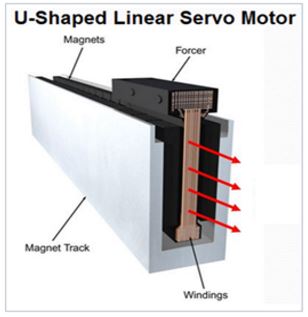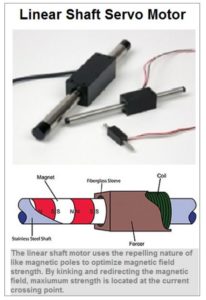Linear Shaft Motors vs Linear Servo Motors
An Independent Review of Energy Efficiency of the Linear Shaft Motor
Linear motors are known to be high precision and high performance compared with traditional systems. High performance servo motors incur losses in many areas. At the coupling, gearbox (if used), and again at the screw in a traditional rotary to linear transmission system. It may be possible that only 55% of the power being supplied is put to work in these systems due to these losses. Screws have a limited critical speed and there is always a factor of resonance in the entire mechanical system. Compare this to a Linear Servo Motor where the motor is not translating motion through mechanics, but directly driving the load linearly which increases the overall efficiency.
Linear motors were once described as a cut open and rolled flat rotary motor. These motors had good success when introduced, but were plagued by eddy currents and cogging which limited the precision applications. The U-shaped Coreless Linear Motor was developed to address these problem areas of the iron core motor.
The design of the U-shape helps alleviate the losses from eddy currents and cogging, but at the price of lower motor stiffness. The U-shape also has greater heat generation, which limits its use in ultra-high-precision applications because of thermal expansion.

Why Use a Linear Shaft Motor vs. a U-Shaped Linear Servo Motor?
Subsequently, linear shaft motors were developed. The Linear Shaft Motor is constructed of permanent magnets stacked in a tube, plus a forcer of cylindrically wound coils about that tube separated by an air gap. Optimized for the most power-efficient linear transmission possible, Linear Shaft Motors maximize stiffness.One of the major advantages of a Linear Shaft Motor is 50% more energy efficiency. The Linear Shaft Motor consumes half the energy of a similar U-Shaped Linear Servo Motor.
One manufacturer, Nippon Pulse Motors, took its Linear Shaft Motor to a leading engineering university to receive an independent evaluation vs. a Trilogy U-shaped linear design to verify these claims. The testing was performed by an Electro-Energy Conversion Professor at the University of Virginia in Charlottesville (UVA).
The results of that test were shared by Nippon Pulse:
“This is to confirm that I tested your linear motors at my office at the University of Virginia. During the sequence of testing, I observed that all comparisons were reasonable, and that each motor executed precisely the same movement sequence. Additionally, I observed that the total energy consumption of the Nippon Pulse unit was 3526 kW hours and the competitive unit was 6803 kW hours. In order to verify the relative calibration of the power meters, I exchanged the meters and re-ran the tests such that each motor was now operating using the meter that had previously been employed on the previous unit. In this test the Nippon Pulse motor consumed 1694 kW hours, while the competitive unit consumed 3213 kW hours. I conclude that the Nippon Pulse motor consumes 0.518 of the energy consumed by the competitive unit, and the tests as presented by Nippon Pulse were both fair and accurate.”
Nippon Pulse’s Linear Shaft Motor is a brushless, high-precision direct drive linear servo motor with a tubular design. The motor consists of a magnetic shaft and coil assembly (forcer), and is driven and controlled by the flow of current. The Linear Shaft Motor can replace ball-screws, pneumatics, U-shaped motors and other linear motion systems. Nippon Pulse’s Linear Shaft Motor is the first linear servomotor designed for the ultra-high-precision market. Its design features greater stiffness, no cogging, a non-critical air gap, and less heat generation, which allow the Linear Shaft Motor to achieve sub-micron resolution.
Design Concepts of the Linear Shaft Motor:
- Simple: two parts and a non-critical air gap
- Non-Contact: no wearing parts and maintenance free
- High Precision: ironless design so all the magnetic flux is used
Linear Shaft Motor Specification Overview:
- Variety of shaft diameters, ranging from 4mm to 100mm
- Stroke lengths of 20mm to 4.6M
- Achievable peak force of 2340N
- Maximum continuous force of 585N

